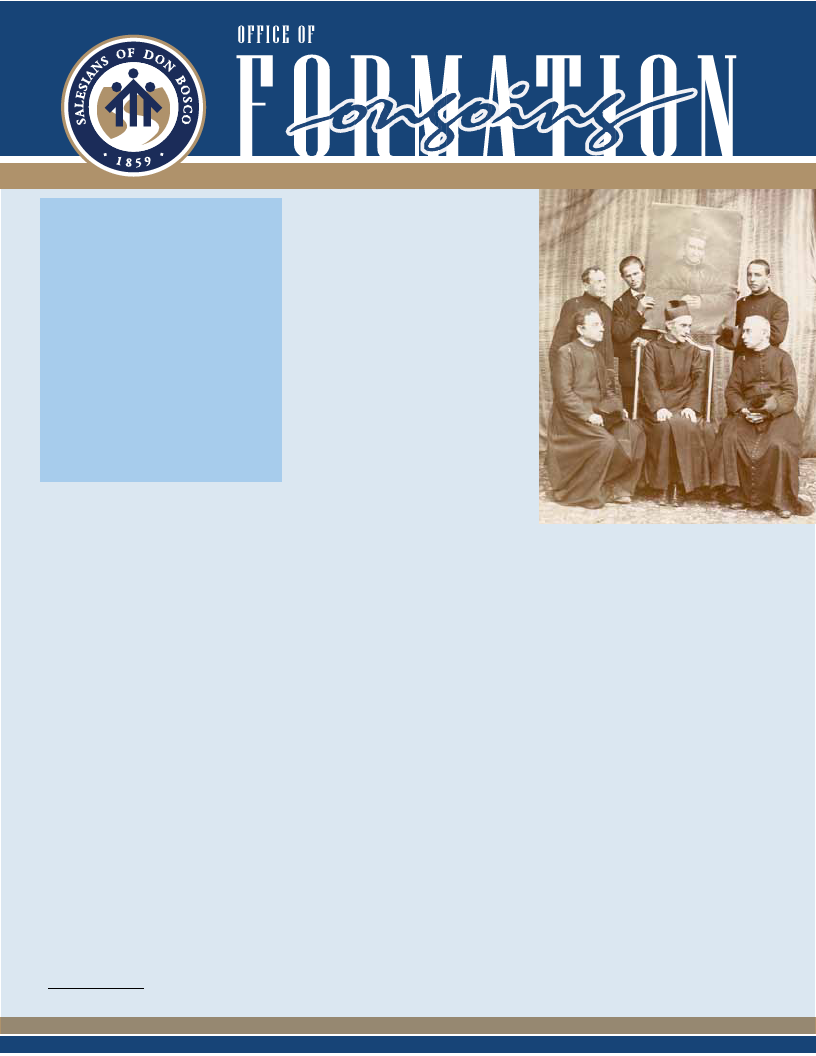
official “approval” (EBM IV, 262 & 527;
IBM IV, 378f.).
(5) June 5, 1952 — The “Seven
Joys of Mary Group.” On the evening
of Saturday, June 5, 1852, Don Bosco
gathered a group of select young
men for a conference, during which
they resolved to recite the Seven Joys
of Mary every Sunday until the first
Saturday of May the following year.
“At that time we shall see how each
of us carried out this resolution.” The
event and the names were recorded
by Michael Rua: [Fr. (or Deacon?)
Joachim] Guanti, [James] Bellia,
[Joseph] Buzzetti, [?] Gianinati, Angelo
Savio, Stephen Savio, [Secundus]
Marchisio, [John] Turchi, [Joseph]
Rocchietti, [John Baptist] Francesia,
Francis Bosco, [John] Cagliero, [John]
Germano, and [Michael] Rua. Of these
fifteen (including Don Bosco) six were
among the founders of the Society
in 1859: Don Bosco, Rua, Cagliero,
Francesia, A. Savio, Buzzetti (EBM IV,
297-298; IBM IV, 428-429).29
6. October 3, 1952 — Michael
Rua and Joseph Rocchietti receive the
clerical habit from Fr. Anthony Cinzano
in the chapel of the Holy Rosary, set up
in the Chapel of Our Lady of the Rosary
attached Joseph’s house at Becchi, in
the presence of the boys taking part
in the fall outing (EBM IV, 337-338;
IBM IV, 487-488; and Cf. note 23 and
related text above).
7. January 26, 1854 — A new
“group of four” meets with Don Bosco.
As the feast of St. Francis de Sales
drew near, Don Bosco kept vaguely
suggesting the thought of a religious
congregation to some of his pupils.
Accordingly, he called a meeting in
which he spoke of the great good that
many people, united as one, could do
to their neighbor, particularly to young
people. Michael Rua recalled the
event in a note that is still preserved
in out archives: “On the evening of
January 26, 1854 we gathered in Don
Bosco’s room. Present were Don Bosco
himself, [Joseph] Rocchietti, [James]
29 Rocchietti became a Salesian but left
the Society, cf. Amadei, Rua I, p. 45, note 2 and
related text.
Artiglia, [John] Cagliero, and [Michael]
Rua. Don Bosco’s proposal was that,
with the help of the Lord and St.
Francis de Sales, we should engage in
a practical exercise of charity toward
neighbor. This would be in view of
making a promise of it—and later, if
possible and appropriate, a vow to
the Lord. From that evening on those
who committed, or would in the future
commit, themselves to this exercise
would be called Salesians” (IBM V, 9;
cf. EBM V, 7-8).30
The significance and the landmark
importance of the year 1854 are
multifaceted. For example, during
this year the Rattazzi-Cavour bill
for the suppression of Religious
Corporations was presented and
discussed in parliament. The great
cholera epidemic was raging in Turin
and in many parts of Italy, and the
four you men who had accepted Don
Bosco’s proposal on January 26, and
others as well, offered their services
for the care of the plague-stricken in
the wards of the city. The Piedmontese
parliament approved Prime Minister
Cavour’s motion for participation in
the Crimean War. In the fall of that
year young Dominic Savio became a
boarder at the Oratory….
Against this background, the
gathering of January 26 stands out as a
watershed in the saga of the formation
of the Salesian Society. For this we
have Don Bosco’s own statements that
locate 1854 as a point of arrival and a
point of departure. Don Bosco’s words
are reported in Barberis’ chronicle
at a time when he had just finished
drafting the Memoirs of the Oratory
(his autobiography).
This evening, ... [Don Bosco] took
time to chat at length about the early
days of the oratory. ... [He said:]
“For now I have set down the most
30 The following should be noted: (1) The
use of the name “Salesian” at this early date
(1854) is disputed. It is not found in Documenti.
It was probably “read back.” (2) The quoted pas-
sage describing the gathering of the “Four” and
the proposal made by Don Bosco to them are
not minutes taken of the meeting of 1854, but
a later note written by Father Rua, probably at
Lemoyne’s request about 1891. The Biographi-
cal Memoirs convey the wrong impression.
8
important things in writing and have
taken the story up to 1854. For it was
around those years that the oratory
acquired stability and gradually took
on the shape it has now. One might
say that with that year the poetic
period came to an end, and the
prosaic period began.”31
In these days [of the yearly
Conferences of St. Francis de Sales],
Don Bosco is continually surrounded
by the directors and by us as well....
In one of our familiar conversations
after supper..., we agreed that it was
important for our congregation to
have a historian.... Then Don Bosco
continued: “As for me, I have set
down a summary account of events
relating to the oratory, from its
beginnings to the present; and up to
1854 [in the Memoirs] the narrative
goes into details in many instances.
From 1854 on, the discourse begins
to be about the congregation, and
matters begin to loom larger and put
on a different face…. Therefore I shall
try to write…. I realize now that Don
Bosco’s life is totally bound to the life
of the Congregation; and therefore
we have to speak of things. The
greater glory of God, the salvation
of souls, and the increase of the
Congregation require that things be
known....”32
31 Barberis, Autograph Chronicle, Note-
book III A, 46-47 (Saturday, Jan. 1, 1876), FDB
835 D9-10 (italics mine)
32 Barberis, Autograph Chronicle, Note-
book IV A, pp. 38-41 (Wednesday, Feb. 2, 1876),
FDB 837 C12 - D1 (italics mine).
Don Rua with Mons. Garlando.








































